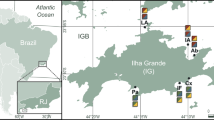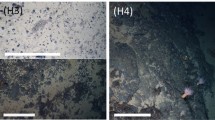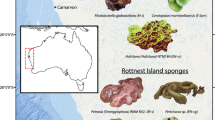Abstract
Australia is increasingly recognised as a global hotspot for sponge biodiversity, but there is a knowledge gap about sponge communities in northern Australia, including those in Commonwealth Marine Reserves. We aim to quantify sponge biodiversity of the eastern Joseph Bonaparte Gulf and adjacent Van Diemen Rise (VDR) and to examine spatial and environmental patterns in community structure. Sponges were collected with a benthic sled from 65 sites encompassing five geomorphic features (bank, terrace, ridge, plain, and valley), study area (as a proxy for distance offshore) and three environmental variables (depth, substrate hardness, and slope). A total of 283 species were collected, representing four classes, 53 families and at least 117 genera. Sponge richness and biomass were related to those of other taxa. Sponge diversity was generally highest further offshore and on raised geomorphic features, particularly banks. Sponge assemblages on the same bank were more similar than those from different banks, although full interpretation of patterns is limited by the relatively low sampling effort. The current study will help facilitate integrated marine management by providing a baseline species inventory, supporting the VDR’s carbonate banks as a key ecological feature, and highlighting the importance of sponges as habitat providers and potential biological surrogates for monitoring.





Similar content being viewed by others
References
Abdo, D. A., 2007. Endofauna differences between two temperate marine sponges (Demospongiae; Haplosclerida; Chalinidae) from southwest Australia. Marine Biology 152: 845–854.
Anderson, M. J., R. N. Gorley & K. R. Clarke, 2008. PERMANOVA+ for PRIMER: Guide to Software and Statistical Methods. PRIMER-E, Plymouth.
Anderson, T. J., S. Nichol, L. Radke, A. D. Heap, C. Battershill, M. Hughes, P. J. Siwabessy, J. V. Barrie, B. Alvarez de Glasby, M. Tran & J. Daniell, 2011. Seabed environments of the Eastern Joseph Bonaparte Gulf, Northern Australia: GA0325/SOL5117 post-survey report. Geoscience Australia Record 2011/08. Geoscience Australia, Canberra: 61 pp.
Bannister, R. J., C. N. Battershill & R. de Nys, 2012. Suspended sediment grain size and mineralogy across the continental shelf of the Great Barrier Reef: impacts on the physiology of a coral reef sponge. Continental Shelf Research 32: 86–95.
Beaulieu, S., 2001. Life on glass houses: sponge stalk communities in the deep sea. Marine Biology 138: 803–817.
Bell, J. J., 2008. The functional roles of marine sponges. Estuarine Coastal and Shelf Science 79: 341–353.
Berman, J., M. Burton, R. Gibbs, K. Lock, P. Newman, J. Jones & J. Bell, 2013. Testing the suitability of a morphological monitoring approach for identifying temporal variability in a temperate sponge assemblage. Journal for Nature Conservation 21: 173–182.
Brown, C. J. & P. Blondel, 2009. Developments in the application of multibeam sonar backscatter for seafloor habitat mapping. Applied Acoustics 70: 1242–1247.
Butler, A., F. Althaus, D. Furlani & K. Ridgway, 2002. Assessment of the Conservation Values of the Bass Strait Sponge Beds Area: A Component of the Commonwealth Marine Conservation Assessment Program 2002–2004. CSIRO and Environment Australia, Canberra: 64 pp.
Cleary, D. F. R., L. E. Becking, N. J. de Voogd, W. Renema, M. de Beer, R. W. M. van Soest & B. W. Hoeksema, 2005. Variation in the diversity and composition of benthic taxa as a function of distance offshore, depth and exposure in the Spermonde Archipelago, Indonesia. Estuarine, Coastal and Shelf Science 65: 557–570.
Commonwealth of Australia, 2008. The north marine bioregional plan. Bioregional profile: a description of the ecosystems, conservation values and uses of the north marine region. Department of Environment, Water, Heritage and the Arts, Canberra: 228 pp.
Commonwealth of Australia, 2012. Marine bioregional plan for the north marine region. Department of Sustainability, Environment, Water, Population and Communities, Canberra: 191 pp.
De Voogd, N. J. & D. F. R. Cleary, 2008. An analysis of sponge diversity and distribution at three taxonomic levels in the Thousand Islands/Jakarta Bay reef complex, West-Java, Indonesia. Marine Ecology 29: 205–215.
De Voogd, N. J., L. E. Becking & D. Cleary, 2009. Sponge community composition in the Derawan Islands, NE Kalimantan, Indonesia. Marine Ecology-Progress Series 396: 169–180.
Department of Conservation and Land Management, 2005. Management plan for the Ningaloo Marine Park and Muiron Islands Marine Management Area 2005–2012. Marine Parks and Reserves Authority, Department of Conservation and Land Management.
Drake, D. E., 1999. Temporal and spatial variability of the sediment grain-size distribution on the Eel shelf: the flood layer of 1995. Marine Geology 154: 169–182.
Duckworth, A. R. & C. Wolff, 2007. Bath sponge aquaculture in Torres Strait, Australia: effect of explant size, farming method and the environment on culture success. Aquaculture 271: 188–195.
Fromont, J., 1994. Reproductive development and timing of tropical sponges (order Haplosclerida) from the Great Barrier Reef. Australia Coral Reefs 13: 127–133.
Fromont, J., 1999. Demosponges of the Houtman Abrolhos. Memoirs of The Queensland Museum 44: 175–183.
Fromont, J., M. A. Vanderklift & G. A. Kendrick, 2006. Marine sponges of the Dampier Archipelago, Western Australia: patterns of species distributions, abundance and diversity. Biodiversity and Conservation 15: 3731–3750.
Fromont, J. & M. A. Vanderklift, 2009. Porifera (sponges) of Mermaid Reef (Rowley Shoals), Scott and Seringapatam Reefs, Western Australia. Records of the Western Australian Museum Supplement 77: 89–104.
Fromont, J., F. Althaus, F. R. McEnnulty, A. Williams, M. Salotti, O. Gomez & K. Gowlett-Holmes, 2012. Living on the edge: the sponge fauna of Australia’s southwestern and northwestern deep continental margin. Hydrobiologia 687: 127–142.
Glasby, C. J., P. C. Schroeder & M. T. Aguado, 2012. Branching out: a remarkable new branching syllid (Annelida) living in a Petrosia sponge (Porifera: Demospongiae). Zoological Journal of the Linnean Society 164: 481–497.
Hall, K. A., 2013. SpongeMaps: An Online Community for Sponge Taxonomy. www.spongemaps.org. Accessed 19 August 2013.
Heap, A. D. & P. T. Harris, 2008. Geomorphology of the Australian margin and adjacent seafloor. Australian Journal of Earth Sciences 55: 555–584.
Heap, A. D., R. Przeslawski, L. Radke, J. Trafford & C. Battershill, 2010. Seabed environments of the Eastern Joseph Bonaparte Gulf, Northern Australia: SOL4934 post-survey report. Geoscience Australia Record 2010/09. Geoscience Australia, Canberra: 81 pp.
Hewitt, J. E., S. F. Thrush, V. J. Cummings & S. J. Turner, 1998. The effect of changing sampling scales on our ability to detect effects of large-scale processes on communities. Journal of Experimental Marine Biology and Ecology 227: 251–264.
Heyward, A., E. Pinceratto & L. Smith, 1997. Big Bank Shoals of the Timor Sea: An Environmental Resource Atlas. Australian Institute of Marine Science & BHP Petroleum, Melbourne. 115 pp.
Heyward, A., J. Fromont, C. H. L. Schönberg, J. Colquhoun, B. Radford & O. Gomez, 2010. The sponge gardens of Ningaloo Reef, Western Australia. The Open Marine Biology Journal 4: 3–11.
Hooper, J. N. A., 1994. Coral reef sponges of the Sahul Shelf: a case study for habitat preservation. Memoirs of the Queensland Museum 36: 93–106.
Hooper, J. N. A. & M. Ekins, 2004. Collation and validation of museum collection databases related to the distribution of marine sponges in Northern Australia. Report to the National Oceans Office Contract C2004/020, Technical reports of the Queensland Museum Number 002, 1–224 (ISBN 978-0-9805692-5-4): 1–224. http://www.environment.gov.au/coasts/mbp/publications/general/nmb-sponge-report.htm. Written for National Oceans Office C2004/020: 224 pp.
Hooper, J. N. A. & J. A. Kennedy, 2002. Small-scale patterns of sponge biodiversity (Porifera) on Sunshine Coast reefs, Eastern Australia. Invertebrate Systematics 16: 637–653.
Hooper, J. N. A., J. A. Kennedy & R. J. Quinn, 2002. Biodiversity ‘hotspots’, patterns of richness and endemism, and taxonomic affinities of tropical Australian sponges (Porifera). Biodiversity and Conservation 11: 851–885.
Hooper, J. N. A., J. A. Kennedy, S. E. List-Armitage, S. D. Cook & R. Quinn, 1999. Biodiversity, species composition and distribution of marine sponges in northeast Australia. Memoirs of the Queensland Museum 44: 263–274.
Hooper, J. N. A. & R. W. M. van Soest (eds), 2002. Systema Porifera: A Guide to the Supraspecific Classification of the Phylum Porifera. Kluwer/Plenum Publishers, New York.
Hooper, J. N. A., K. A. Hall, M. Ekins, D. Erpenbeck, G. Wörheide & G. Jolley-Rogers, 2013. Managing and sharing the escalating number of sponge “Unknowns”: the SpongeMaps Project. Integrative and Comparative Biology 53: 473–481.
Huang, Z., B. P. Brooke & P. T. Harris, 2011. A new approach to mapping marine benthic habitats using physical environmental data. Continental Shelf Research 31: S4–S16.
Kelly, T. & R. Przeslawski, 2012. The ecology and morphology of sponges and octocorals in the northeastern Joseph Bonaparte Gulf. Geoscience Australia Record 2012/67. Geoscience Australia, Canberra: 81 pp.
Laport, M. S., O. C. Santos & G. Muricy, 2009. Marine sponges: potential sources of new antimicrobial drugs. Current Pharmaceutical Biotechnology 10: 86–105.
Leal, M. C., J. Puga, J. Serôdio, N. C. M. Gomes & R. Calado, 2012. Trends in the discovery of new marine natural products from invertebrates over the last two decades: where and what are we bioprospecting? PLoS One 7: e30580.
Mariani, S., M. J. Uriz, X. Turon & T. Alcoverro, 2006. Dispersal strategies in sponge larvae: integrating the life history of larvae and the hydrologic component. Oecologia 149: 174–184.
McArthur, M., B. Brooke, R. Przeslawski, D. A. Ryan, V. Lucieer, S. Nichol, A. W. McCallum, C. Mellin, I. D. Cresswell & L. C. Radke, 2010. On the use of abiotic surrogates to describe marine benthic biodiversity Estuarine Coastal and Shelf. Science 88: 21–32.
McDonald, J. I., J. N. A. Hooper & K. A. McGuinness, 2002. Environmentally influenced variability in the morphology of Cinachyrella australiensis (Carter 1886) (Porifera: Spirophorida: Tetillidae). Marine and Freshwater Research 53: 79–84.
Mellin, C., M. J. Caley, M. G. Meekan, A. Williams, P. Dunstan, G. J. Edgar, R. Przeslawski, C. R. Pitcher & C. J. A. Bradshaw, 2011. Determining the effectiveness of biological surrogates for predicting biodiversity patterns. PLoS One 6(6): e20141.
Ninio, R., S. Delean, K. Osborne & H. Sweatman, 2003. Estimating cover of benthic organisms from underwater video images: variability associated with multiple observers. Marine Ecology-Progress Series 265: 107–116.
Pile, A. J. & C. M. Young, 2006. The natural diet of a hexactinellid sponge: benthic–pelagic coupling in a deep-sea microbial food web. Deep Sea Research 53: 1148–1156.
Pitcher, C. R., Doherty, P., Arnold, P., Hooper, J., Gribble, N., Bartlett, C., Browne, M., Campbell, N., Cannard, T., Cappo, M., Carini, G., Chalmers, S., Cheers, S., Chetwynd, D., Colefax, A., Coles, R., Cook, S., Davie, P., De’ath, G., Devereux, D., Done, B., Donovan, T., Ehrke, B., Ellis, N., Ericson, G., Fellegara, I., Forcey, K., Furey, M., Gledhill, D., Good, N., Gordon, S., Haywood, M., Jacobsen, I., Johnson, J., Jones, M., Kinninmoth, S., Kistle, S., Last, P., Leite, A., Marks, S., McLeod, I., Oczkowicz, S., Rose, C., Seabright, D., Sheils, J., Sherlock, M., Skelton, P., Smith, D., Smith, G., Speare, P., Stowar, M., Strickland, C., Sutcliffe, P., Van der Geest, C., Venables, W., Walsh, C., Wassenberg, T., Welna, A., Yearsley, G. 2007. Seabed biodiversity on the continental shelf of the Great Barrier Reef World Heritage Area. AIMS/CSIRO/QM/QDPI CRC Reef Research Task Final Report, 315 pp. ISBN 9781921232879 (pbk.). ISBN 9781921232886 (web). (CSIRO Marine & Atmospheric Research: Hobart, Cleveland).
Pitcher, C. R., R. Pears, M. Dunning, P. J. Doherty & J. N. A. Hooper, 2011. Understanding and managing the effects of trawling on the seabed in the Great Barrier Reef. Queensland State of the Environment Report 2011.
Przeslawski, R., J. Daniell, T. Anderson, J. V. Barrie, A. Heap, M. G. Hughes, J. Li, A. Potter, L. Radke, J. Siwabessy, M. Tran, T. Whiteway & S. Nichol, 2011. Seabed habitats and hazards of the Joseph Bonaparte Gulf and Timor Sea, Northern Australia. Geoscience Australia Record 2011/40. Geoscience Australia, Canberra: 156 pp.
Riberio, S. M., E. P. Omena & G. Muricy, 2003. Macrofauna associated to Mycale microsigmatosa (Porifera, Demospongiae) in Rio de Janeiro State, SE Brazil. Estuarine Coastal and Shelf Science 57: 951–959.
Roberts, D. E. & A. R. Davis, 1996. Patterns in sponge (Porifera) assemblages on temperate coastal reefs off Sydney, Australia. Marine and Freshwater Research 47: 897–906.
Roberts, D. E., S. P. Cummins, A. R. Davis & M. G. Chapman, 2006. Structure and dynamics of sponge-dominated assemblages on exposed and sheltered temperate reefs. Marine Ecology-Progress Series 321: 19–30.
Rützler, K., 1978. Sponges in coral reefs. In Stoddart, D. E. & J. E. Johannes (eds), Coral Reefs: Research Methods, Monographs on Oceanographic Methodology, 5. UNESCO, Paris: 299–313.
Schlacher, T. A., M. A. Schlacher-Hoenlinger, A. Williams, F. Althaus, J. N. A. Hooper & R. Kloser, 2007. Richness and distribution of sponge megabenthos in continental margin canyons off southeastern Australia. Marine Ecology-Progress Series 340: 73–88.
Schönberg, C. H. L., 2008. A history of sponge erosion: from past myths and hypotheses to recent approaches. In Wisshak, M. & L. Tapanila (eds), Current Developments in Bioerosion. Springer, Berling: 165–202.
Schönberg, C. H. L. & J. Fromont, 2011. Sponge gardens of Ningaloo Reef (Carnarvon Shelf, Western Australia) are biodiversity hotspots. Hydrobiologia 687: 143–161.
Sipkema, D., M. C. R. Granssen, R. Osinga, J. Tramper & R. H. Wijffels, 2005. Marine sponges as pharmacy. Marine Biotechnology 7: 142–162.
Smale, D. A., G. A. Kendrick, K. I. Waddington, K. P. Van Niel, J. J. Meeuwig & E. S. Harvey, 2010. Benthic assemblage composition on subtidal reefs along a latitudinal gradient in Western Australia. Estuarine Coastal and Shelf Science 86: 83–92.
Sorokin, S., J. Fromont & D. Currie, 2007. Demosponge biodiversity in the benthic protection zone of the Great Australian Bight. Transactions of the Royal Society of South Australia 132: 192–204.
Spalding, M. D., H. E. Fox, G. R. Allen, N. Davidson, Z. A. Ferdaña, M. Finlayson, B. S. Halpern, M. A. Jorge, A. Lombana, S. A. Lourie, K. D. Martin, E. McManus, J. Molnar, C. A. Recchia & J. Robertson, 2007. Marine ecoregions of the world: a bioregionalization of coastal and shelf areas. Bioscience 57: 573–583.
Stowe, S. D., J. J. Richards, A. T. Tucker, R. Thompson, C. Melander & J. Cavanagh, 2011. Anti-biofilm compounds derived from marine sponges. Marine Drugs 9: 2010–2035.
Sutcliffe, P. R., J. N. A. Hooper & C. R. Pitcher, 2010. The most common sponges on the Great Barrier Reef seabed, Australia, include species new to science (Phylum Porifera). Zootaxa 2616: 1–30.
Sutcliffe, P. R., C. R. Pitcher, M. J. Caley & H. P. Possingham, 2012. Biological surrogacy in tropical seabed assemblages fails. Ecological Applications 22: 1762–1771.
Tabachnick, K. R., D. Janussen & L. L. Menschenina, 2008. New Australian Hexactinellida (Porifera) with a revision of Euplectella aspergillum. Zootaxa 1866: 7–68.
Thomas, T. R. A., D. P. Kavlekar & P. A. LokaBharathi, 2010. Marine drugs from sponge–microbe association: a review. Marine Drugs: 81417–81468.
van Soest, R. W. M., N. Boury-Esnault, J. Vacelet, M. Dohrmann, D. Erpenbeck, N. J. De Voogd, N. Santodomingo, B. Vanhoorne, M. Kelly & J. N. A. Hooper, 2012. Global diversity of sponges (Porifera). PloS One 7: e35105.
van Soest, R. W. M., N. Boury-Esnault, J. Hooper, N. J. de Voogd, B. Alvarez, E. Hajdu, A. Pisera, J. Vacelet, R. Manconi, C. Schoenberg, D. Janussen, K. R. Tabachnick, M. Dohrmann, M. Klautau, B. E. Picton, M. Kelly & M. C. Díaz, 2013. World Porifera database. http://www.marinespecies.org/porifera. Last consulted on 1 February 2013.
Ward, T. M., S. J. Sorokin, D. R. Currie, P. J. Rogers & L. J. McLeay, 2006. Epifaunal assemblages of the eastern Great Australian Bight: effectiveness of a benthic protection zone in representing regional biodiversity. Continental Shelf Research 26: 25–40.
Webster, N. S. & L. L. Blackall, 2008. What do we really know about sponge–microbial symbioses? The International Society for Microbial Ecology Journal 3: 1–3.
Wilkinson, C. R. & A. C. Cheshire, 1989. Patterns in the distribution of sponge populations across the central Great Barrier Reef. Coral Reefs 8: 127–134.
Wilkinson, C. R. & E. Evans, 1989. Sponge distribution across Davies Reef, Great Barrier Reef, relative to location, depth, and water movement. Coral Reefs 8: 1–7.
Wulff, J. L., 2006. Ecological interactions of marine sponges. Canadian Journal of Zoology 84: 146–166.
Yang, J. K., J. Sun, O. O. Lee, Y. H. Wong & P. Y. Qian, 2011. Phylogenetic diversity and community structure of sponge-associated bacteria from mangroves of the Caribbean Sea. Aquatic Microbial Ecology 62: 231–232.
Acknowledgments
The taxonomic identification of sponges was partially supported by the ‘Collection and Taxonomy of Shallow Water Marine Organisms’ program for the US National Cancer Institute (Contract N02-CM-27003) subcontracted to MAGNT through Coral Reef Research Foundation. We are grateful to the scientific and ship crews of the R.V. Solander during surveys SOL4934 and SOL5117. Zhi Huang and Olivia Wilson assisted with ArcGIS tools and hydrographic charts, respectively. Tanya Whiteway, Floyd Howard, Scott Nichol, Justy Siwabessy, and Kim Pritchard provided physical datasets. Riko Hashimoto, Scott Nichol, Andrew Carroll, Kim Pritchard and Nic Bax provided valuable comments on previous drafts of this manuscript. MAGNT volunteers, Garrick Foy, Alyson Malpartida, and Neil Lugdvisen assisted with the curation of samples. This work was undertaken as part of the Marine Biodiversity Hub, a collaborative partnership supported through funding from the Australian Government’s National Environmental Research Program (NERP). This paper is published with the permission of the Chief Executive Officer, Geoscience Australia.
Author information
Authors and Affiliations
Corresponding author
Additional information
Handling editor: Vasilis Valavanis
Electronic supplementary material
Below is the link to the electronic supplementary material.
Rights and permissions
About this article
Cite this article
Przeslawski, R., Alvarez, B., Battershill, C. et al. Sponge biodiversity and ecology of the Van Diemen Rise and eastern Joseph Bonaparte Gulf, northern Australia. Hydrobiologia 730, 1–16 (2014). https://doi.org/10.1007/s10750-013-1799-8
Received:
Revised:
Accepted:
Published:
Issue Date:
DOI: https://doi.org/10.1007/s10750-013-1799-8




